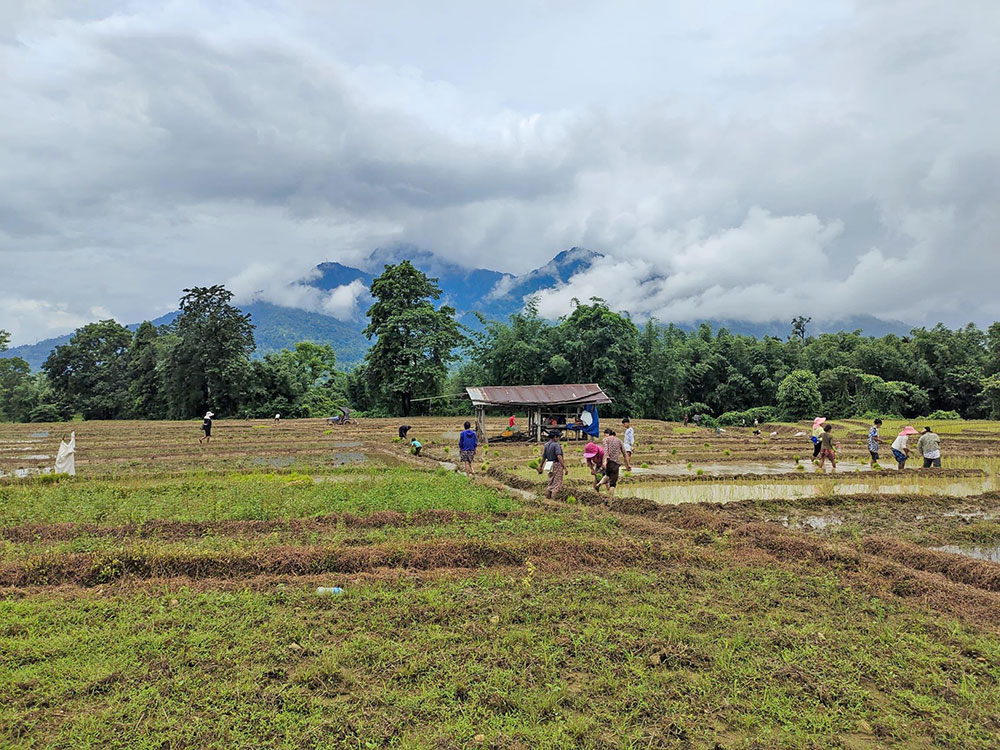Lhakpa Quendren
Gelephu—The promising economic prospects linked to the planned Gelephu Mindfulness City (GMC) have ignited a rush to purchase land in Sarpang Dzongkhag, substantially shooting up land prices.
While attempts by Kuensel to obtain land transaction records from the Sarpang Dzongkhag Land Record Office were unsuccessful, sources indicate that over 50 transactions occur daily, making it one of the highest transaction rates among dzongkhags in the country.
As the GMC project edges closer to implementation, both residents and land brokers anticipate a sustained increase in land purchases, with surging demand already pushing prices higher.
A local real estate agent said that most buyers are business owners from Thimphu. “Although land value continues to rise, prices here remain affordable for low-income households,” he added.
Buyers are motivated by the advantages that Sarpang and Gelephu offer, while sellers cite reasons such as loan repayments and a shortage of workforce for managing their land.
A resident of Umling is selling her one acre and 60 decimal land for Nu 110,000 per decimal. “My parents are aging, and I work in a workshop in Gelephu. There’s no one to take care of the land that has remained fallow for years.”
Unlike in the past, there is now an uptick in sales of orchards, cardamom farms, and wetlands, with some transactions involving as much as three acres of wetland.
“Even though wetlands cannot be converted to dry land, buyers believe this might change, as has been the case in Thimphu,” said one buyer.
Most buyers opt for smaller plots of 15 to 20 decimals of dry land, although some are securing larger parcels of up to 150 decimals, according to real estate agents.
Buyers are opting to invest on the other side of Gelephu—Serzhong, Chuzargang, Umling, and Tareythang—while those in Sarpang and Gelephu towns, as well as Gelephu gewog, are struggling to attract buyers due to high rates.
“Many think it is better to invest in 50 decimal of rural land than in a 15-decimal plot in an urban area for the same value,” a real estate agent said.
A random price comparison indicates an increase of over 18 percent in prices over the last six months. For instance, prices in the gewogs opposite Gelephu now range from Nu 25,000 to Nu 130,000 per decimal, depending on their locations, up from Nu 10,000 to Nu 110,000 per decimal in March of this year.
Dechenpelri (Edi) in Samtenling Gewog is also seeing increased demand, with prices hovering between Nu 190,000 and Nu 220,000 per decimal.
The rapid price escalation is evident. A resident who bought a 50-decimal plot in Dekiling gewog for Nu 66,500 per decimal in October 2023 sold it for Nu 130,000 per decimal—a nearly 100 percent increase in just one year.
Meanwhile, land prices in the villages of Zomlingthang, Pemathang, and Lekithang in Gelephu gewog, located near the airport, have stagnated due to uncertainties regarding potential inclusion in airport development projects.
A plot near the airport sold for as low as Nu 190,000 per decimal, while others fetch between Nu 220,000 and 280,000 per decimal.
A plot near the Gelephu gewog centre recently sold for Nu 250,000 per decimal, considerably lower than the over Nu 300,000 per decimal previously achieved.
In 2021, land prices in Zomlingthang and Pelrithang were between Nu 150,000 and Nu 160,000 per decimal respectively.
The current market prices in Sheychamthang town range from Nu 150,000 to Nu 200,000 per decimal while prices range between Nu 70,000 and Nu 100,000 per decimal in Gakiling and Singye.
The price in the core town remains above Nu 1 million per decimal while land in urban village (UV) 2 sells for around Nu 700,000 per decimal and about Nu 550,000 per decimal in UV 3.
Some residents in Gelephu town and surrounding areas are also selling their properties to invest in rural locations where land is available at lower prices.
Unregulated real estate trading
The allure of the GMC has led to a surge in unregulated real estate trading, raising concerns among industry professionals about price manipulation. For instance, two brokers acquired approximately four acres at Nu 23,300 per decimal, subsequently fragmenting it into smaller plots and selling them for between Nu 37,000 and Nu 44,000 per decimal.
Another broker in Gelephu said that he keeps a profit margin of about Nu 10,000 per decimal. So far, he has sold three acres of land at Nu 90,000 per decimal, earning Nu 300,000 in profit. He is currently negotiating a deal on a 80-decimal plot.
Real estate owners said that while land sales are rising, they are yet to benefit significantly. “Real estate firms must pay taxes, but the market is dominated by brokers,” a real estate owner said.
“Brokers are selling land at significantly higher prices on top of the already inflated land values. They even influence buyers by claiming that the transaction could close at any time, fueling rumors of another moratorium,” she added. “The authorities need to look into this issue.”
A resident also accused a local government leader of the gewog of engaging in brokering by not approving land applications, citing that the land was controversial, and later selling them at inflated prices.
While the Property Assessment and Valuation Agency (PAVA) sets benchmarks for land valuation, reliable sources indicate that many buyers and sellers attempt to underreport sale prices to evade the three percent land ownership transfer tax.
The government compensation for property acquisition in Sarpang ranges from Nu 2,767.33 to Nu 13,030.69 per decimal for dry land (Kamzhing), Nu 2,490.60 to Nu 7,818.42 per decimal for wetland (Chhuzhing), and Nu 3,804.58 to Nu 13,431.13 per decimal for cash crops.
The compensation rate for Sarpang Dzongkhag Throm in Shechamthang and Tar ranges from Nu 5,673.47 per decimal in environmental-1 to Nu 94,398.88 per decimal in the urban hub. And the rate for Gelephu Thromde varies from Nu 145,769.18 per decimal in environmental-1 to Nu 611,094.53 per decimal in urban core-1.


